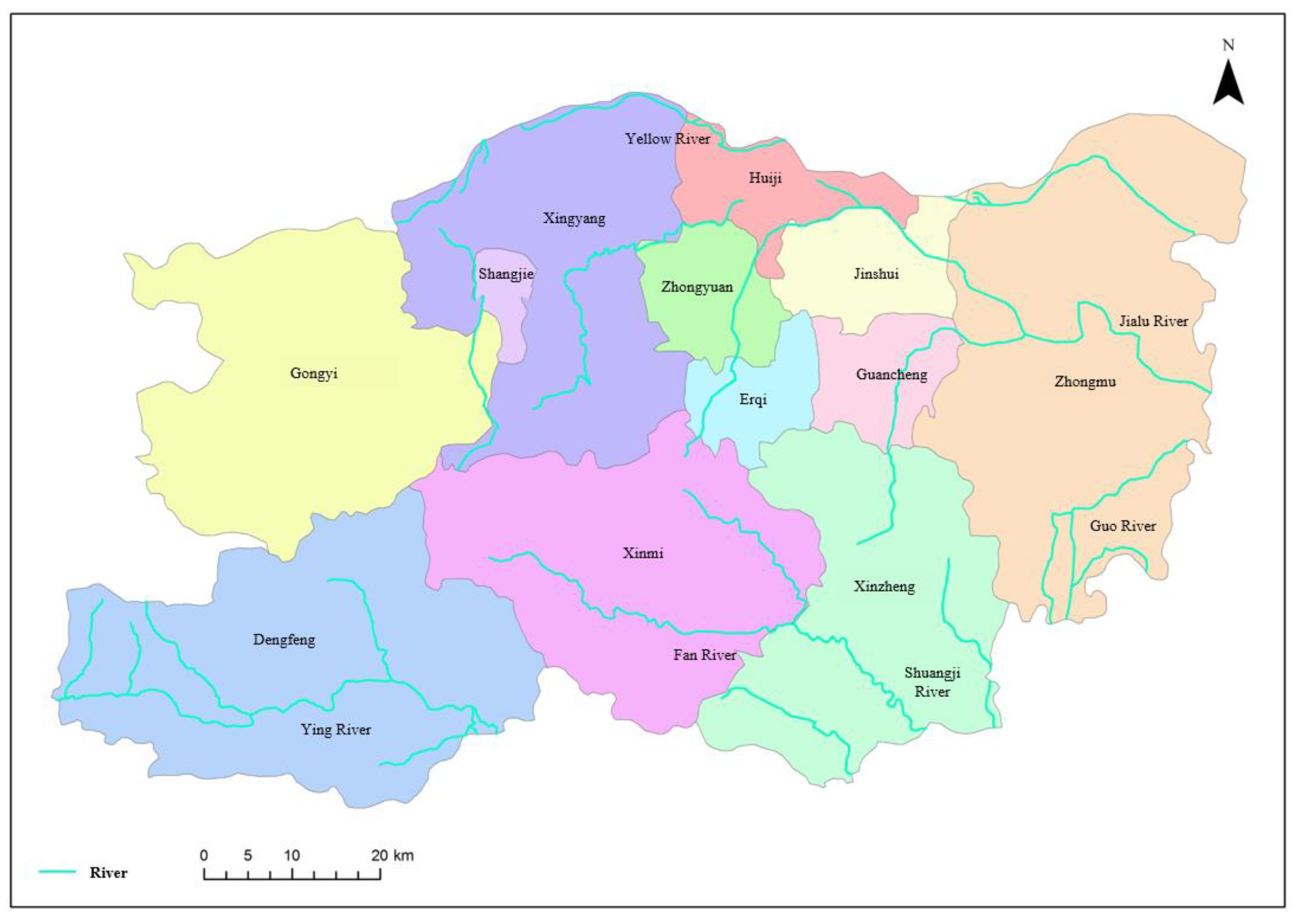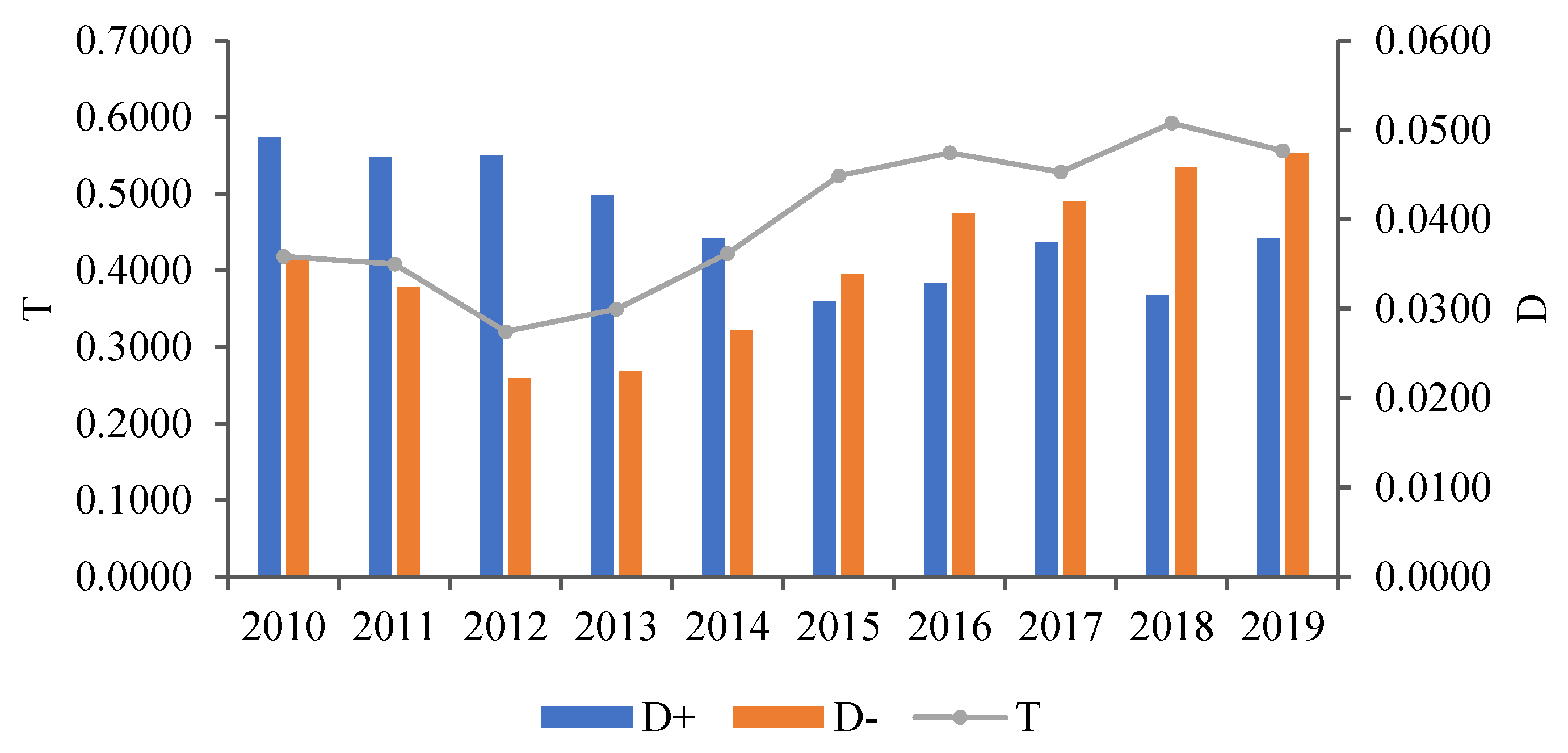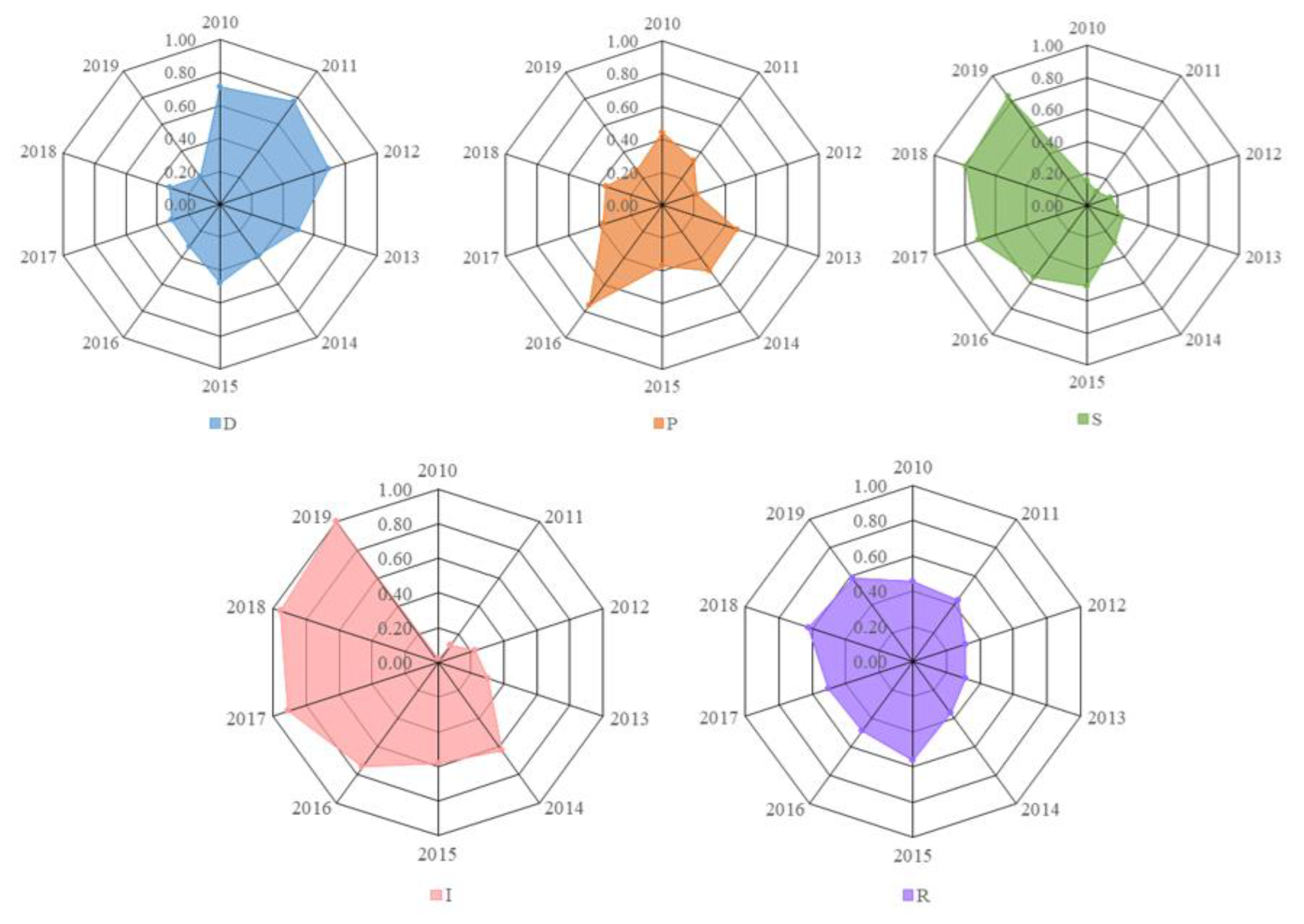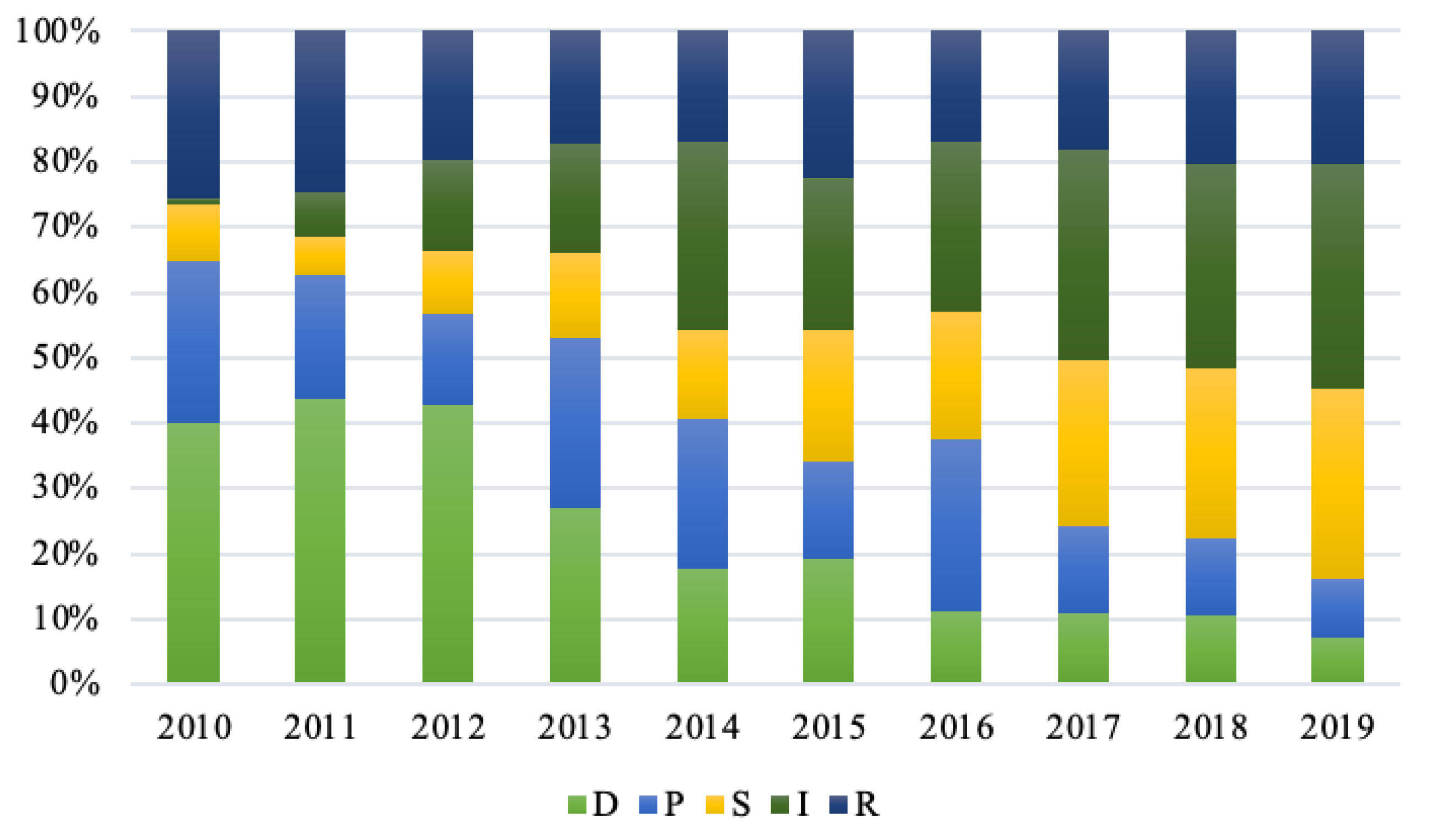Study on Water Resource Carrying Capacity of Zhengzhou City Based on DPSIR Model
Abstract
:1. Introduction
2. Materials and Methods
2.1. Research Region
2.2. Data Resource
2.3. Research Methods
2.3.1. Construction of Water Resource Carrying Capacity Index System
2.3.2. Index Weight Determination
- (1)
- The original data are standardized
- (2)
- The entropy Hj of the index is calculated
- (3)
- The weight value of the evaluation index is calculated as follows
2.3.3. Evaluation Model of Water Resources Carrying Capacity
- (1)
- Preprocessing of original data
- (2)
- Calculation of normalized matrix Z
- (3)
- Construction of weighted normalized matrix X
- (4)
- Determination of positive and negative ideal solutions
- (5)
- Calculation of distances of the evaluation object from the positive ideal solution and negative ideal solution, respectively.
- (6)
- Calculation of the closeness degree between the evaluation object and the ideal solution
3. Results and Analysis
3.1. Determination of Index Weight
3.2. Evaluation Results and Analysis of Water Resources Carrying Capacity of Zhengzhou
3.3. Evaluation Results and Analysis of Water Resources Carrying Capacity Subsystems of Zhengzhou
4. Conclusions
- (1)
- From 2010 to 2019, the comprehensive evaluation values of water resource carrying capacity of Zhengzhou rose from 0.4183 to 0.5560, presenting a steadily increasing trend. Simultaneously, the grade of water resource carrying capacity improved from Grade III of normal carrying to Grade II of good carrying during the sample period. Among them, the lowest evaluation value of water resource carrying capacity was in 2012, i.e., 0.3201, whereas the highest evaluation value was in 2018, i.e., 0.5922. The latter is close to 185% of the former. Furthermore, the contribution of each subsystem to the comprehensive evaluation value increased year by year. Relatively, the contributions of the S subsystem and I subsystem to comprehensive carrying capacity were the greatest. The contribution of the R subsystem is stable. Affected by GDP growth rate and uneven temporal–spatial distribution of water resources in Zhengzhou, the carrying capacities of the D subsystem and P subsystem show the fluctuating change.
- (2)
- The combination weighting method was used to determine the index weight, which better avoids the influences of human subjective factors and data. Moreover, the difference between the status quo and the ideal value of water resource carrying capacity can be intuitively found by using the TOPSIS model. The evaluation results basically accord with the actual situation in Zhengzhou. Due to the data’s availability, this paper could only evaluate the water resource carrying capacity of Zhengzhou before 2019, which is the deficiency of this paper that needs to be improved in the future.
- (3)
- The water resource carrying capacity of Zhengzhou has significantly increased in recent years but is still at a general or lower level. In this regard, the sustainable utilization of water resources remains challenging. As a central city, Zhengzhou is experiencing a shortage of water resources, fragile water ecological environment, large population pressure, urgent upgrade of industrial structure, etc. Therefore, as the economy and urban construction are vigorously developed, some measures should be adopted, such as the reinforcement of residents’ awareness of water conservation, strengthening of the implementation of water ecological protection measures, improvement of the investment amount in the water conservancy project, introduction of high-tech industry, and a decrease in industrial water consumption, so as to further improve the water resource carrying capacity and promote the sustainable utilization of water resources.
Author Contributions
Funding
Institutional Review Board Statement
Informed Consent Statement
Data Availability Statement
Conflicts of Interest
References
- Duan, X.G.; Luan, F.F. Evaluation of Water Resources Carrying Capacity in Xinjiang Based on Fuzzy Comprehensive Model. Model. China Popul. Resour. Environ. 2014, 24, 119–122. [Google Scholar]
- Li, P.; Qian, H. Water resources research to support a sustainable China. Int. J. Water Resour. Dev. 2018, 34, 327–336. [Google Scholar] [CrossRef] [Green Version]
- Wang, H.; Huang, J.; Zhou, H. Analysis of sustainable utilization of water resources based on the improved water resources ecological footprint model: A case study of Hubei Province, China. J. Environ. Manag. 2020, 262, 110331. [Google Scholar] [CrossRef] [PubMed]
- He, L.; Du, Y.; Wu, S. Evaluation of the agricultural water resource carrying capacity and optimization of a planting-raising structure. Agric. Water Manag. 2021, 243, 106456. [Google Scholar] [CrossRef]
- Yang, Z.; Song, J.; Cheng, D. Comprehensive evaluation and scenario simulation for the water resources carrying capacity in Xi’an city, China. J. Environ. Manag. 2019, 230, 221–233. [Google Scholar] [CrossRef] [PubMed]
- Sun, B.; Yang, X. Simulation of water resources carrying capacity in Xiong’an New Area based on system dynamics model. Water 2019, 11, 1085. [Google Scholar] [CrossRef] [Green Version]
- Swirepik, J.L.; Burns, I.C.; Dyer, F.J. Establishing Environmental Water Requirements for the Murray–Darling Basin, Australia’s Largest Developed River System. River Res. Appl. 2016, 32, 1153–1165. [Google Scholar] [CrossRef]
- Al-Kalbani, M.S.; Price, M.F.; O’Higgins, T. Integrated environmental assessment to explore water resources management in Al Jabal Al Akhdar, Sultanate of Oman. Reg. Environ. Chang. 2016, 16, 1345–1361. [Google Scholar] [CrossRef]
- Cao, L.J.; Zhang, X.P. Assessment of water resources carrying capacity in Gansu Province based on principal component analysis. Arid. Land Geogr. 2017, 40, 906–912. [Google Scholar]
- Feng, X.; Jiang, W.L.; Liu, Y.; Li, X.R. Progress of research on fuzzy mathematical model of water resources value. Resour. Sci. 2021, 43, 1834–1848. [Google Scholar] [CrossRef]
- Xu, K.L.; Lu, H.S.; Zhu, Y.H. Simulation of water resources carrying capacity based on system dynamics. J. Water Resour. Water Eng. 2020, 31, 67–72. [Google Scholar]
- Chen, J.; Jiskani, I.M.; Jin, L.C. Evaluation and future framework of green mine construction in China based on the DPSIR model. Sustain. Environ. Res. 2020, 30, 13. [Google Scholar] [CrossRef]
- Zare, F.; Elsawah, S.; Bagheri, A. Improved integrated water resource modelling by combining DPSIR and system dynamics conceptual modelling techniques. J. Environ. Manag. 2019, 246, 27–41. [Google Scholar] [CrossRef]
- Zhang, N.N.; Li, X.L.; Zhou, Y.Z.; Niu, J.P. Water resources carrying capacity evaluation of the Yellow River Basin based on EFAST weight algorithm. J. Nat. Resour. 2019, 34, 1759–1770. [Google Scholar] [CrossRef]
- Wang, J.H.; Jiang, D.C.; Xiao, W.H. Study on theoretical analysis of water resources carrying capacity: Definition and scientific topics. J. Hydraul. Eng. 2017, 48, 1399–1409. [Google Scholar]
- Irfan, M.; Elavarasan, R.M.; Ahmad, M. Prioritizing and overcoming biomass energy barriers: Application of AHP and G-TOPSIS approaches. Technol. Forecast. Soc. Chang. 2022, 177, 121524. [Google Scholar] [CrossRef]
- Solangi, Y.A.; Tan, Q.; Mirjat, N.H. Evaluating the strategies for sustainable energy planning in Pakistan: An integrated SWOT-AHP and Fuzzy-TOPSIS approach. J. Clean. Prod. 2019, 236, 117655. [Google Scholar] [CrossRef]
- Song, H.; Lu, B.; Ye, C. Fraud vulnerability quantitative assessment of Wuchang rice industrial chain in China based on AHP-EWM and ANN methods. Food Res. Int. 2021, 140, 109805. [Google Scholar] [CrossRef] [PubMed]
- Xi, H.; Li, Z.; Han, J. Evaluating the capability of municipal solid waste separation in China based on AHP-EWM and BP neural network. Waste Manag. 2022, 139, 208–216. [Google Scholar] [CrossRef]
- Wang, H.; Wang, X.; Bi, L. Multi-objective optimization of water and fertilizer management for potato production in sandy areas of northern China based on TOPSIS. Field Crop. Res. 2019, 240, 55–68. [Google Scholar] [CrossRef]
- Liu, D.; Qi, X.; Li, M. A resilience evaluation method for a combined regional agricultural water and soil resource system based on Weighted Mahalanobis distance and a Gray-TOPSIS mode. J. Clean. Prod. 2019, 229, 667–679. [Google Scholar] [CrossRef]
- Li, Z.; Yang, T.; Huang, C.S. An improved approach for water quality evaluation: TOPSIS-based informative weighting and ranking (TIWR) approach. Ecol. Indic. 2018, 89, 356–364. [Google Scholar] [CrossRef]
- Su, X.B.; Li, X.G.; Zhao, J.F. Carrying capacity of water resources system coupling water resources with water environment thresholds. Resour. Sci. 2018, 40, 1016–1025. [Google Scholar]
- Yu, C.; Li, Z.; Yang, Z. A feedforward neural network based on normalization and error correction for predicting water resources carrying capacity of a city. Ecol. Indic. 2020, 118, 106724. [Google Scholar] [CrossRef]
- Lv, A.; Han, Y.; Zhu, W. Risk assessment of water resources carrying capacity in China. JAWRA J. Am. Water Resour. Assoc. 2021, 57, 539–551. [Google Scholar] [CrossRef]




| Evaluation Factor | Evaluation Index | Unit | Index Attribute | Index Code |
|---|---|---|---|---|
| Driving force (D) | GDP growth rate | % | + | D1 |
| Natural population growth rate | ‰ | + | D2 | |
| Urbanization rate | % | + | D3 | |
| Population density | Persons/km2 | + | D4 | |
| Pressure (P) | Water consumption per capita | m3 | − | P1 |
| Residents’ water consumption | 100 million m3 | − | P2 | |
| The total amount of discharged sewage | 100 million m3 | − | P3 | |
| Water consumption of industrial added value | m3/ten thousand yuan | − | P4 | |
| State (S) | Sewage treatment rate | % | + | S1 |
| Total water consumption | 100 million m3 | − | S2 | |
| Green coverage rate | % | + | S3 | |
| Water consumption per 10,000 yuan of GDP | m3/ten thousand yuan | − | S4 | |
| Impact (I) | Water quality compliance rate of water sources | % | + | I1 |
| Water quality compliance rate of sections | % | + | I2 | |
| Per capita disposal income | Ten thousand yuan | + | I3 | |
| Proportion of tertiary industry | % | + | I4 | |
| Response (R) | Water resource stock | 100 million m3 | + | R1 |
| Water resource assets | 100 million yuan | + | R2 | |
| Investment of water conservancy project | 100 million yuan | + | R3 |
| Grade | Grade V | Grade IV | Grade III | Grade II | Grade I |
|---|---|---|---|---|---|
| Grade description | Serious overloading | Mild overloading | Normal carrying | Good carrying | Surplus carrying |
| (0–0.25] | (0.25–0.35] | (0.35–0.55] | (0.55–0.75] | (0.75–1] |
| Evaluation Factor | Index Code | AHP Weight (W1) | Entropy Weight (W2) | Combination Weight(W) |
|---|---|---|---|---|
| D | D1 | 0.3317 | 0.2852 | 0.0726 |
| (0.2004) | D2 | 0.1972 | 0.2267 | 0.0343 |
| D3 | 0.3317 | 0.2801 | 0.0713 | |
| D4 | 0.1394 | 0.2081 | 0.0223 | |
| P | P1 | 0.2865 | 0.2860 | 0.0848 |
| (0.2663) | P2 | 0.2026 | 0.2186 | 0.0458 |
| P3 | 0.3407 | 0.2745 | 0.0968 | |
| P4 | 0.1703 | 0.2209 | 0.0389 | |
| S | S1 | 0.1409 | 0.3274 | 0.0230 |
| (0.1212) | S2 | 0.4105 | 0.2280 | 0.0467 |
| S3 | 0.1273 | 0.2039 | 0.0129 | |
| S4 | 0.3212 | 0.2406 | 0.0386 | |
| I | I1 | 0.2053 | 0.2368 | 0.0297 |
| (0.1534) | I2 | 0.3453 | 0.2656 | 0.0560 |
| I3 | 0.2053 | 0.2692 | 0.0337 | |
| I4 | 0.2441 | 0.2284 | 0.0340 | |
| R | R1 | 0.4934 | 0.3477 | 0.1327 |
| (0.2587) | R2 | 0.3108 | 0.3054 | 0.0734 |
| R3 | 0.1958 | 0.3469 | 0.0525 |
| Year | D+ | D− | T |
|---|---|---|---|
| 2010 | 0.0491 | 0.0353 | 0.4183 |
| 2011 | 0.0469 | 0.0324 | 0.4083 |
| 2012 | 0.0471 | 0.0222 | 0.3201 |
| 2013 | 0.0427 | 0.0230 | 0.3494 |
| 2014 | 0.0378 | 0.0276 | 0.4217 |
| 2015 | 0.0308 | 0.0339 | 0.5236 |
| 2016 | 0.0328 | 0.0406 | 0.5534 |
| 2017 | 0.0375 | 0.0419 | 0.5282 |
| 2018 | 0.0316 | 0.0458 | 0.5922 |
| 2019 | 0.0378 | 0.0473 | 0.5560 |
| Year | D | P | S | I | R |
|---|---|---|---|---|---|
| 2010 | 0.7095 | 0.4410 | 0.1524 | 0.0169 | 0.4538 |
| 2011 | 0.7673 | 0.3296 | 0.1026 | 0.1213 | 0.4323 |
| 2012 | 0.6884 | 0.2227 | 0.1536 | 0.2238 | 0.3140 |
| 2013 | 0.4934 | 0.4794 | 0.2368 | 0.3051 | 0.3150 |
| 2014 | 0.3848 | 0.4915 | 0.2947 | 0.6267 | 0.3655 |
| 2015 | 0.4795 | 0.3692 | 0.5061 | 0.5824 | 0.5600 |
| 2016 | 0.3163 | 0.7538 | 0.5606 | 0.7429 | 0.4841 |
| 2017 | 0.3060 | 0.3763 | 0.7073 | 0.9083 | 0.5044 |
| 2018 | 0.3224 | 0.3602 | 0.7966 | 0.9548 | 0.6212 |
| 2019 | 0.2076 | 0.2620 | 0.8394 | 1.0000 | 0.5840 |
Disclaimer/Publisher’s Note: The statements, opinions and data contained in all publications are solely those of the individual author(s) and contributor(s) and not of MDPI and/or the editor(s). MDPI and/or the editor(s) disclaim responsibility for any injury to people or property resulting from any ideas, methods, instructions or products referred to in the content. |
© 2023 by the authors. Licensee MDPI, Basel, Switzerland. This article is an open access article distributed under the terms and conditions of the Creative Commons Attribution (CC BY) license (https://creativecommons.org/licenses/by/4.0/).
Share and Cite
Jia, Y.; Wang, H. Study on Water Resource Carrying Capacity of Zhengzhou City Based on DPSIR Model. Int. J. Environ. Res. Public Health 2023, 20, 1394. https://doi.org/10.3390/ijerph20021394
Jia Y, Wang H. Study on Water Resource Carrying Capacity of Zhengzhou City Based on DPSIR Model. International Journal of Environmental Research and Public Health. 2023; 20(2):1394. https://doi.org/10.3390/ijerph20021394
Chicago/Turabian StyleJia, Yizhen, and Han Wang. 2023. "Study on Water Resource Carrying Capacity of Zhengzhou City Based on DPSIR Model" International Journal of Environmental Research and Public Health 20, no. 2: 1394. https://doi.org/10.3390/ijerph20021394
APA StyleJia, Y., & Wang, H. (2023). Study on Water Resource Carrying Capacity of Zhengzhou City Based on DPSIR Model. International Journal of Environmental Research and Public Health, 20(2), 1394. https://doi.org/10.3390/ijerph20021394




